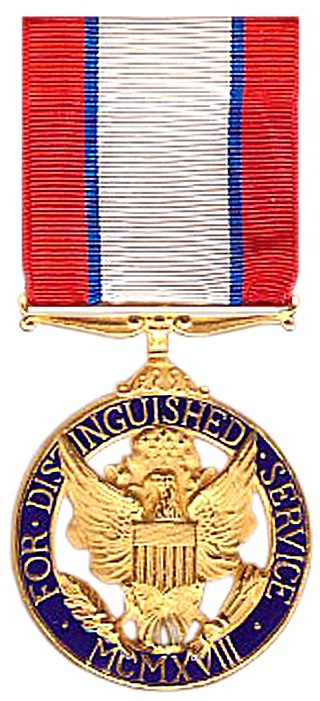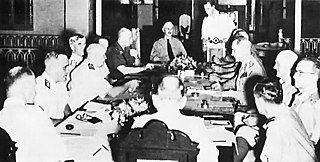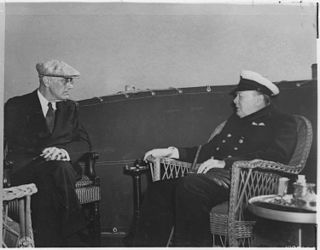
The Distinguished Service Medal (DSM) is a military decoration of the United States Army that is presented to soldiers who have distinguished themselves by exceptionally meritorious service to the government in a duty of great responsibility. The performance must be such as to merit recognition for service that is clearly exceptional. The exceptional performance of normal duty will not alone justify an award of this decoration.

The Cairo Conference also known as the First Cairo Conference, was one of the 14 summit meetings during World War II that occurred on November 22–26, 1943. The Conference was held at Cairo in Egypt between China, the United Kingdom and the United States. It outlined the Allied position against the Empire of Japan during World War II and made decisions about post-war Asia. The conference was attended by Chairman Chiang Kai-shek, British Prime Minister Winston Churchill and US President Franklin D. Roosevelt.

The Joint Chiefs of Staff (JCS) is the body of the most senior uniformed leaders within the United States Department of Defense, which advises the president of the United States, the secretary of defense, the Homeland Security Council and the National Security Council on military matters. The composition of the Joint Chiefs of Staff is defined by statute and consists of a chairman (CJCS), a vice chairman (VJCS), the chiefs of the Army, Marine Corps, Navy, Air Force, Space Force, and the chief of the National Guard Bureau. Each of the individual service chiefs, outside their JCS obligations, works directly under the secretaries of their respective military departments, e.g. the secretary of the Army, the secretary of the Navy, and the secretary of the Air Force.

Field Marshal Alan Francis Brooke, 1st Viscount Alanbrooke,, was a senior officer of the British Army. He was Chief of the Imperial General Staff (CIGS), the professional head of the British Army, during the Second World War, and was promoted to field marshal on 1 January 1944. As chairman of the Chiefs of Staff Committee, Brooke was the foremost military advisor to Prime Minister Winston Churchill, and had the role of co-ordinator of the British military efforts in the Allies' victory in 1945. After retiring from the British Army, he served as Lord High Constable of England during the Coronation of Queen Elizabeth II in 1953. His war diaries attracted attention for their criticism of Churchill and for Brooke's forthright views on other leading figures of the war.
Operation Sledgehammer was an Allied plan for a cross-Channel invasion of Europe during World War II, as the first step in helping to reduce pressure on the Soviet Red Army by establishing a Second Front. It was to be executed in 1942 and acted as a contingency alternative to Operation Roundup, the original Allied plan for the invasion of Europe in 1943. Allied forces were to seize the French Atlantic ports of either Brest or Cherbourg and areas of the Cotentin Peninsula during the early autumn of 1942, and amass troops for a breakout in the spring of 1943.

Ernest Joseph King was a fleet admiral in the United States Navy who served as Commander in Chief, United States Fleet (COMINCH) and Chief of Naval Operations (CNO) during World War II. He directed the United States Navy's operations, planning, and administration and was a member of the Joint Chiefs of Staff and was the U.S. Navy's second-most senior officer in World War II after Fleet Admiral William D. Leahy, who served as Chairman of the Joint Chiefs of Staff.
Europe first, also known as Germany first, was the key element of the grand strategy agreed upon by the United States and the United Kingdom during World War II after the United States joined the war in December 1941. According to this policy, the United States and the United Kingdom would use the preponderance of their resources to subdue Nazi Germany in Europe first. Simultaneously, they would fight a holding action against Japan in the Pacific, using fewer resources. After the defeat of Germany—considered the greatest threat to the UK and the Soviet Union—all Allied forces could be concentrated against Japan.

William Daniel Leahy was an American naval officer. The most senior United States military officer on active duty during World War II, he held several titles and exercised considerable influence over foreign and military policy. As a fleet admiral, he was the first flag officer ever to hold a five-star rank in the U.S. Armed Forces.

Field Marshal Sir John Greer Dill, was a senior British Army officer with service in both the First World War and the Second World War. From May 1940 to December 1941 he was the Chief of the Imperial General Staff, the professional head of the British Army, and subsequently served in Washington, D.C., as Chief of the British Joint Staff Mission and then Senior British Representative on the Combined Chiefs of Staff.

The American-British-Dutch-Australian (ABDA) Command, or ABDACOM, was the short-lived supreme command for all Allied forces in South East Asia in early 1942, during the Pacific War in World War II. The command consisted of the forces of Australia, the Netherlands, United Kingdom and the United States. The main objective of the command, led by General Sir Archibald Wavell, was to maintain control of the "Malay Barrier", a notional line running down the Malay Peninsula, through Singapore and the southernmost islands of the Dutch East Indies. ABDACOM was also known in British military circles as the "South West Pacific Command", although it should not be confused with the later South West Pacific Area command.

The Casablanca Conference or Anfa Conference was held in Casablanca, French Morocco, from January 14 to 24, 1943, to plan the Allied European strategy for the next phase of World War II. The main discussions were between US President Franklin Roosevelt and British Prime Minister Winston Churchill. Stalin could not attend. Key decisions included a commitment to demand Axis powers' unconditional surrender; plans for an invasion of Sicily and Italy before the main invasion of France; an intensified strategic bombing campaign against Germany; and approval of a US Navy plan to advance on Japan through the central Pacific and the Philippines. The last item authorized the island-hopping campaign in the Pacific, which shortened the war. Of all the decisions made, the most important was the invasion of Sicily, which Churchill pushed for in part to divert American attention from opening a second front in France in 1943, a move that he feared would result in very high Allied casualties and not be possible until 1944.

South West Pacific Area (SWPA) was the name given to the Allied supreme military command in the South West Pacific Theatre of World War II. It was one of four major Allied commands in the Pacific War. SWPA included the Philippines, Borneo, the Dutch East Indies, East Timor, Australia, the Territories of Papua and New Guinea, and the western part of the Solomon Islands. It primarily consisted of United States and Australian forces, although Dutch, Filipino, British and other Allied forces also served in the SWPA.
The First Washington Conference, also known as the Arcadia Conference, was held in Washington, D.C., from December 22, 1941, to January 14, 1942. President Roosevelt of the United States and Prime Minister Churchill of the United Kingdom attended the conference, where they discussed a future United Nations.

The Malta Conference was held from January 30 to February 3, 1945 between President Franklin D. Roosevelt of the United States and Prime Minister Winston Churchill of the United Kingdom on the island of Malta. The purpose of the conference was to plan the final campaign against the Germans with the Combined Chiefs of Staff. Politically, the overriding purpose was to present a united front against Stalin in the Yalta Conference a few days later. That did not happen once Yalta began, much to Churchill's disappointment. Both leaders agreed on the undesirability of the Red Army advancing into central Europe.

The Allied leaders of World War II listed below comprise the important political and military figures who fought for or supported the Allies during World War II. Engaged in total war, they had to adapt to new types of modern warfare, on the military, psychological and economic fronts.
Brigadier Vivian Dykes,, known as Dumbie Dykes, was a British civil servant and officer of the Royal Engineers, who ultimately died serving in the Second World War.

The ANZAC Area, also called the ANZAC Command, was a short-lived naval military command for Allied forces defending the northeast approaches to Australia including the Fiji Islands, New Hebrides, and New Caledonia during the early stages of the Pacific Campaign of World War II. The command was created on 27 January 1942. United States Navy Vice Admiral Herbert Fairfax Leary commanded the force. The force co-existed with the Allied ABDA command which was charged with defending Allied colonial territories in Southeast Asia and the Southwest Pacific from Imperial Japanese aggression.

The Combined Munitions Assignments Board was a major government agency for the U.S. and Britain in World War II. With Harry Hopkins, Roosevelt's top advisor in charge, it took control of the allocation of war supplies and Lend lease aid to the Allies, especially Britain and the Soviet Union.

The UK-US relations in World War II comprised an extensive and highly complex relationships, in terms of diplomacy, military action, financing, and supplies. British Prime Minister Winston Churchill and American President Franklin D. Roosevelt formed close personal ties, that operated apart from their respective diplomatic and military organizations.














